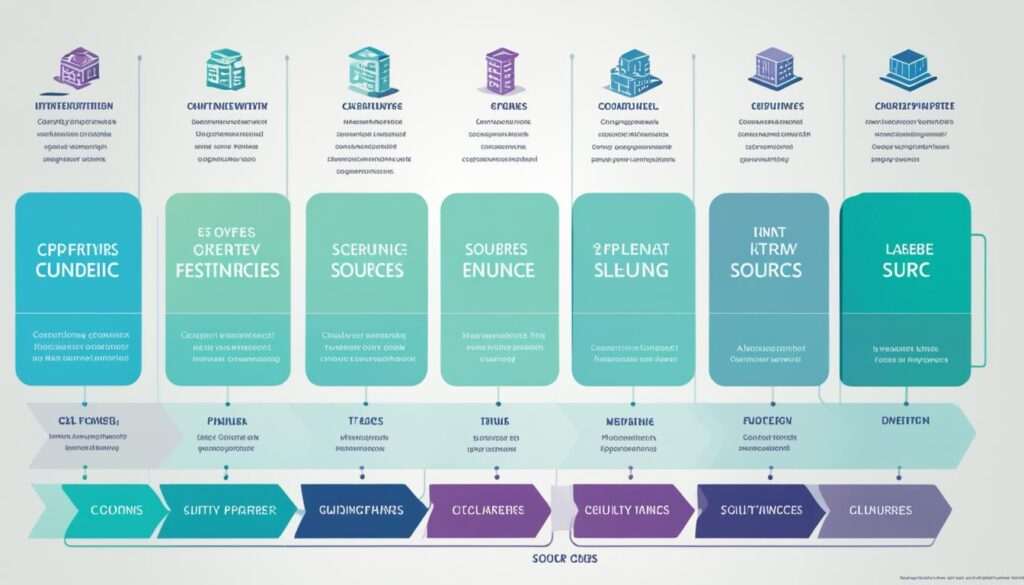When it comes to venture capital (VC) firms, there’s a common perception that these well-known players in the startup funding ecosystem use their own personal wealth to back promising entrepreneurs and their innovative ideas. But is this really the case? The answer may surprise you.
As you delve into the world of venture capital, you’ll find that the reality is quite different from the mythical image of VC firms bankrolling startups with their own money. In fact, the vast majority of the capital invested by VC firms comes from a pool of investors known as limited partners (LPs).
So, if VC firms aren’t using their own money, where does all that startup funding come from? Let’s take a closer look at the inner workings of the venture capital industry to uncover the truth behind the funding sources.
Key Takeaways
- Venture capital firms raise funds from limited partners (LPs), not their own personal wealth.
- The general partners (GPs) who manage the VC firm typically invest around 1-20% of the fund’s capital as their “skin in the game.”
- The perception of VC firms using their own money to invest in startups is a common myth.
- Understanding the venture capital ecosystem is crucial for entrepreneurs seeking funding.
- The role of VC firms in supporting innovation and entrepreneurship extends beyond just providing funding.
Understanding Venture Capital Firms
Venture capital firms play a crucial role in the entrepreneurial ecosystem, serving as vital sources of funding and guidance for innovative startups. These specialized investment firms are at the heart of the venture capital (VC) industry, orchestrating the flow of capital and expertise that fuels the growth of promising young companies.
What is a Venture Capital Firm?
A venture capital firm is a management company, known as the “ManCo,” that oversees one or more investment funds. The general partners (GPs) who make up the VC firm are responsible for identifying and investing in startups with high growth potential. They use the capital raised from limited partners (LPs), such as institutional investors and wealthy individuals, to provide financing and support to these entrepreneurial ventures.
The Role of Venture Capitalists
Venture capitalists are more than just providers of capital; they are active partners in the success of the startups they invest in. Beyond financial resources, they offer invaluable guidance, industry expertise, and access to their extensive professional networks. Venture capitalists take on the role of “trail-wise sidekicks,” helping entrepreneurs navigate the challenges of building and scaling a business in exchange for a stake in the company’s future growth and profitability.

| Key Characteristics of Venture Capital Firms | Responsibilities of Venture Capitalists |
|---|---|
|
|
Myths vs. Realities of Venture Capital
The venture capital industry is often shrouded in misconceptions and myths, fueling misunderstandings about the realities of startup financing. As we delve into the facts, it’s essential to separate the common myths from the real-world truths about venture capitalists and the role they play in the entrepreneurial ecosystem.
Common Myths About Venture Capitalists
One of the prevailing myths is that venture capital is the primary source of funding for startups. In reality, angel investors fund far more companies than venture capital firms. Another common misconception is that VCs take big risks with their investments. However, the data suggests that venture capitalists are often insulated from risk by hefty annual fee streams, contrary to the perception of their high-risk appetite.
Perhaps the most persistent myth is that the venture capital industry generates spectacular returns. Surprisingly, the facts reveal that less cash has been returned to VC investors than they have invested since 1997, challenging the notion of venture capital as a surefire path to outsized profits.
Debunking the Misconceptions
As we peel back the layers of these venture capital myths and VC misconceptions, a clearer picture emerges. The startup funding realities and entrepreneurial financing landscape is far more nuanced than the romanticized notions often portrayed. By understanding the VC industry facts, entrepreneurs and investors can make more informed decisions and navigate the venture capital ecosystem with greater clarity.

| Myth | Reality |
|---|---|
| Venture capital is the primary source of startup funding | Angel investors fund far more companies than venture capital firms |
| VCs take big risks with their investments | Venture capitalists are often insulated from risk by hefty annual fee streams |
| Venture capital generates spectacular returns | Less cash has been returned to VC investors than they have invested since 1997 |
Do VC firms use their own money?
Contrary to popular belief, venture capital firms do not typically use their own personal money to invest in startups. The factual data from the sources clearly indicates that VC firms raise capital primarily from limited partners (LPs) who contribute the majority (around 99%) of the funds in a VC fund.
This model of VC firm funding sources means that the general partners (GPs) who manage the VC firm are not risking their own personal wealth when making investments. Instead, they are investing the capital contributed by the LPs, which are often institutional investors, wealthy individuals, or endowments. The GPs may invest a small portion (typically 1-20%) of the fund’s capital as their own “skin in the game,” but the vast majority of the funding comes from the VC personal investment of the LPs.
This structure of startup financing models allows VC firms to leverage the capital of their LPs to identify and invest in promising startups and entrepreneurs, while limiting their own personal financial exposure. By raising funds from outside sources, VC firms can diversify their investments and manage risk more effectively than if they were relying solely on their own money.
| Funding Source | Percentage of VC Fund |
|---|---|
| Limited Partners (LPs) | ~99% |
| General Partners (GPs) | 1-20% |
This table highlights the typical breakdown of VC firm funding sources, with the majority of the capital coming from LPs and a smaller portion from the personal investment of the GPs who manage the VC firm. This model allows VC firms to leverage a diversified pool of capital to support and grow innovative startups, while managing their own financial risk exposure.

The Venture Capital Ecosystem
Understanding the intricate workings of the venture capital ecosystem is crucial for entrepreneurs seeking funding and investors looking to participate in the growth of innovative startups. At the heart of this ecosystem are two key players: general partners (GPs) and limited partners (LPs).
General Partners (GPs) and Limited Partners (LPs)
The general partners, or GPs, are the individuals who make up the venture capital firm and are responsible for managing the investment funds. They are the ones who identify promising startups, conduct due diligence, and make investment decisions on behalf of the fund. On the other hand, the limited partners, or LPs, are the outside investors who contribute the majority of the capital to the VC funds. These LPs can include institutional investors, wealthy individuals, endowments, and other financial entities.
Fund Structure and Management Fees
The venture capital fund structure is designed to align the interests of the GPs and LPs. Typically, GPs invest a small portion of their own capital (usually around 1-20%) into the fund, ensuring they have “skin in the game” and are incentivized to generate strong returns. The remaining capital is raised from the LPs, who contribute the majority of the funds. In exchange for their management and investment expertise, the GPs charge an annual management fee, typically ranging from 1.5% to 2.5% of the total assets under management.
By understanding the venture capital ecosystem, the roles of GPs and LPs, and the fund structure and management fees, entrepreneurs and investors can navigate the complex world of venture capital more effectively and make informed decisions that align with their goals and objectives.

Investing Strategies of Venture Capitalists
Contrary to popular belief, venture capitalists do not solely focus on investing in good ideas or business plans. Instead, they often target industries that are more competitively forgiving than the broader market, as revealed in the second source. This strategic approach to VC investment strategies helps them mitigate risk and identify promising sectors poised for growth.
Identifying Promising Industries
Venture capitalists meticulously analyze industry trends, consumer behaviors, and competitive landscapes to pinpoint startup industry analysis and identify the most promising sectors for investment. By focusing on industries with higher barriers to entry, less intense competition, and favorable market dynamics, VCs can increase their chances of achieving significant returns for their limited partners (LPs).
Deal Structuring and Risk Mitigation
Venture capitalists employ sophisticated VC deal terms and structures to manage and mitigate risk. This includes negotiating favorable terms, such as preferred stock, control provisions, and exit options, to protect their investments and ensure alignment with the founders’ interests. Additionally, VCs often diversify their portfolios to spread venture capital risk management and minimize the impact of individual startup failures.

The Role of Venture Capital in Entrepreneurship
Venture capital has long played a crucial role in supporting entrepreneurship and driving innovation. While the factual data has highlighted some of the myths and misconceptions surrounding the venture capital industry, it also underscores the immense value that VC firms bring to the table for aspiring entrepreneurs and startups.
Funding Innovative Startups
One of the primary ways in which venture capital firms contribute to entrepreneurship is by providing much-needed funding for innovative startups. VC investors are often willing to take on higher risks in exchange for the potential of outsized returns, enabling them to back ambitious, high-growth companies that may struggle to secure financing from more traditional sources. This infusion of capital allows entrepreneurs to transform their ideas into reality, scale their businesses, and compete in rapidly evolving markets.
Mentorship and Guidance
Venture capitalists not only bring financial resources to the table but also a wealth of industry knowledge, networks, and strategic guidance. VC firms typically employ experienced professionals who have extensive expertise in various sectors, business models, and growth strategies. By partnering with entrepreneurs, these VC experts can provide invaluable mentorship, connect founders with key industry contacts, and help navigate the complex challenges of building a successful startup.
The entrepreneur-VC relationship is often a symbiotic one, with both parties contributing unique strengths to the venture. Entrepreneurs bring their innovative ideas, passion, and drive, while VC firms leverage their VC value-add to foster the growth and success of these startups. This dynamic interplay between VC role in entrepreneurship and startup funding has been instrumental in the rise of numerous transformative companies that have disrupted their respective industries.

Venture Capital Returns and Performance
As the venture capital (VC) industry continues to evolve, the question of VC fund returns and overall industry performance has become a topic of increasing interest. While the perception of venture capital often paints a picture of spectacular returns, the reality may not always align with this narrative.
Historical Returns of VC Funds
According to the data, the venture capital industry has faced some challenges in generating consistent, superior returns for its investors. The first source highlights a surprising statistic, noting that “since 1997 less cash has been returned to VC investors than they have invested.” This suggests that the venture capital fund returns may not have lived up to the industry’s reputation for generating outsized gains.
Factors Influencing Fund Performance
The factors driving VC industry performance are multifaceted and complex. While venture capitalists are often portrayed as risk-takers, the data reveals that “today’s venture capitalists are more conservative bankers than the risk-takers of the past.” This shift in mindset, coupled with the reality that a typical VC partner spends less than two hours per week on any given company within a portfolio of 10 companies, highlights the importance of factors driving VC fund success beyond the traditional narrative.
Additionally, the sources indicate that venture capitalists tend to invest in industries that are “more competitively forgiving than the market as a whole.” This strategic approach to identifying promising sectors may be a key factor in optimizing venture capital fund returns and navigating the complexities of the startup ecosystem.

As the venture capital industry continues to evolve, understanding the nuances of VC industry performance and the factors that influence venture capital fund success will be crucial for both investors and entrepreneurs seeking to leverage the power of VC funding to drive innovation and growth.
Emerging Trends in Venture Capital
As the venture capital (VC) industry continues to evolve, several emerging trends are shaping the way startups are funded and innovative ventures are supported. One significant development is the rise of online fundraising platforms and crowdfunding, which are disrupting the traditional VC model and providing new avenues for entrepreneurs to access capital.
Online Platforms and Crowdfunding
Platforms like AngelList and SecondMarket have emerged as innovative solutions for startup funding, allowing investors to participate in early-stage companies through online channels. According to the data, these platforms have facilitated significant growth in online fundraising, with Crowdwise estimating that $214.9 million was raised through equity crowdfunding platforms in 2020. Furthermore, StartEngine, a leading crowdfunding platform, raised $147 million for private companies in 2020, representing a remarkable year-over-year growth rate of 236% compared to 2019.
Impact Investing and Sustainable Ventures
Alongside the rise of online fundraising, there has been a growing emphasis on impact investing and supporting sustainable startups. Venture capitalists are increasingly recognizing the importance of backing companies that prioritize environmental, social, and governance (ESG) factors, as well as those addressing pressing global challenges. This shift reflects the broader societal demand for businesses that create positive change while delivering financial returns.
As the venture capital landscape continues to evolve, these emerging trends in online fundraising platforms and impact investing are reshaping the way startups secure funding and the types of ventures that are attracting VC attention. Entrepreneurs and investors alike must stay attuned to these developments to navigate the rapidly changing VC industry trends and capitalize on new opportunities in the years ahead.

Navigating the Venture Capital Landscape
As the venture capital industry continues to evolve, it is crucial for both entrepreneurs seeking funding and venture capitalists aiming to invest in promising startups to navigate the landscape with diligence and strategic foresight. This section offers valuable insights and practical guidance to help you successfully maneuver the complex dynamics between VC funding for entrepreneurs and the entrepreneur-VC relationship, while also highlighting the best practices for VC firm best practices and startup-VC dynamics.
Tips for Entrepreneurs Seeking VC Funding
For entrepreneurs in pursuit of venture capital, it is essential to understand the nuances of the entrepreneur-VC relationship and the investment criteria that VC firms prioritize. Crafting a compelling business plan, demonstrating a deep understanding of your target market, and showcasing a talented and experienced founding team are crucial steps in capturing the attention of venture capitalists. Additionally, fostering meaningful connections within the VC network and leveraging industry referrals can significantly improve your chances of securing funding.
It is also important for entrepreneurs to approach the fundraising process with a clear understanding of their company’s valuation and the terms they are willing to accept. Negotiating the VC funding for entrepreneurs deal structure with transparency and integrity can help establish a strong partnership between the startup and the investing VC firm, setting the stage for long-term success.
Best Practices for Venture Capitalists
For venture capitalists, maintaining a disciplined and strategic approach to investment decisions is paramount. This includes thoroughly evaluating the startup-VC dynamics and the potential for sustainable growth within target industries, as well as carefully structuring deals to mitigate risk and align incentives with the entrepreneurs.
Successful VC firms also recognize the value of providing hands-on guidance and mentorship to their portfolio companies. By leveraging their industry expertise and networks, venture capitalists can help entrepreneurs navigate challenges, refine their strategies, and capitalize on emerging opportunities, fostering a mutually beneficial entrepreneur-VC relationship.
Additionally, VC firms that prioritize VC firm best practices, such as fostering a collaborative and transparent culture, maintaining a diverse investment portfolio, and continuously evaluating and adapting their investment thesis, are more likely to achieve consistent, long-term success in the venture capital landscape.
| Key Considerations for Entrepreneurs | Best Practices for Venture Capitalists |
|---|---|
|
|
By navigating the venture capital landscape with a strategic mindset, both entrepreneurs and venture capitalists can forge mutually beneficial relationships, drive innovation, and achieve long-term success in the dynamic and ever-evolving startup ecosystem.

Conclusion
In conclusion, the factual data gathered from various sources provides a comprehensive overview of the venture capital industry and its pivotal role in the broader startup funding landscape. The venture capital ecosystem, with its intricate web of general partners (GPs) and limited partners (LPs), offers a unique avenue for entrepreneurs seeking to transform their innovative ideas into thriving businesses.
While the venture capital industry is often shrouded in myths and misconceptions, the data has shed light on the realities of VC funding, including the fact that VC firms do not typically use their own money to invest in startups. Instead, they raise capital from a diverse pool of LPs, ranging from wealthy individuals to institutional investors, who contribute the majority of the funds in a VC fund.
As the venture capital industry continues to evolve, we are witnessing the emergence of innovative trends, such as the rise of online fundraising platforms and the growing emphasis on impact investing and sustainable ventures. These developments underscore the dynamic nature of the startup funding landscape and the adaptability of the venture capital ecosystem to meet the changing needs of entrepreneurs and investors.
Looking ahead, the future of venture capital holds immense promise, with the potential to drive sustainable innovation, foster VC-entrepreneur relationships, and shape the venture capital industry overview. As the landscape continues to evolve, it will be essential for both entrepreneurs and venture capitalists to stay informed, adaptable, and attuned to the latest trends and best practices in the industry.
